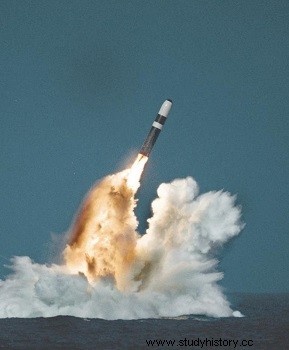
In Britain, nuclear propulsion studies had been their train until the late 1950s, but progress was slow, and in 1958 an agreement was reached with the Americans for the complete supply of a reactor. This was installed on the Dreadnought which was the first British nuclear submarine, which entered service in 1963.
American law strictly prohibited the communication of information concerning nuclear propulsion to other nations — an exception was made for the British — so only three nations had nuclear submarines until, in 1969, testing began of the French nuclear-powered ballistic missile submarine Le Redoutable. It was a particularly courageous step by the French Navy because it was not only embarking on the discovery of an entirely new mode of propulsion for it, but in addition in the same hull it had introduced a weapon system which was no less so.
In America, indeed, the credibility of the strategic bombers carrying the atomic bomb and the few land-based missiles was increasingly put in
doubt. We had therefore pressed the studies of the Jupiter missile to determine if it was possible to use it at sea. Finally, we created another one, which was called A-1 or Polaris.
It was designed to be launched from a fully submerged submarine that would carry 16 of them, arranged in 16 vertical launch tubes placed on Skipjack-class vessels under construction in the late 1950s. of them, the Scorpion, laid down in 1957 and renamed George Washington, was the first ballistic Polaris submarine. This transformation included •the insertion of an additional section nearly 40 meters long in a hull that developed 76.55 meters, to accommodate two rows of eight tubes.
Of course, the Polaris A-1 which carried only 1,250 miles was soon replaced by the A-2, which carried a range of 1,500 miles, and eventually by the A 3 which carried 2,500. Since completion George Washington at the end of 1959, 40 other Polaris submarines were built in the United States and finally, 31 of them are equipped with Poseidon. With the same range as the Polaris A-3, the latter has several independent nuclear warheads capable of attacking several targets or serving as traps to defend against anti-missile missiles.
The British Navy, following an agreement made with the United States in 1962, received the plans and information necessary to build four (a fifth was cancelled) Polaris submarines. The first, Resolution, was completed in 1967. Under the terms of the agreements, only the bodies of the missile are built in the United States as well as a battery of computers; the head is entirely British made.
The unexpected collapse of the Visigothic kingdom was a historical catastrophe so absolute and of such caliber that it is not surprising that successive generations of historians have raised questions and proposed explanations for it. In this post we will answer the question of why a State that had
